
How to landscape with edible
plants
You can get twice as much from your garden with half the work!
By Marion Owen, Fearless Weeder
for PlanTea, Inc. and
Co-author of Chicken Soup for the Gardener's Soul
FEATURE ARTICLE:

Tom Hanks' "Power of Four" solution
More good stuff:
Who is Marion Owen?
FAQs about PlanTea
Search Marion's articles, tips and recipes
Why grow organic?
News and press releases
Read love letters
How to link to this site
Need a speaker?
How to contact Marion
Visiting Alaska?
Come to Kodiak Island!
Go to home page

Marion's UpBeet Gardener
Newsletter has been
replaced by Marion's blog
which you can find at:
www.marionowen.wordpress.com
 Have
you ever wanted to get more out of your garden? You can, by landscaping
with edible plants. Edible landscaping, especially when paired with organic
gardening practices, enhances any yard, garden or landscape. Is that great, or what?
Have
you ever wanted to get more out of your garden? You can, by landscaping
with edible plants. Edible landscaping, especially when paired with organic
gardening practices, enhances any yard, garden or landscape. Is that great, or what?
Plants that do double duty
Stick with me, and you'll discover how easy it is to combine fruit-bearing shrubs, herbs, vegetables and flowers. You'll also learn how to put edible landscaping into practice, no matter what size garden you have. I'll also provide you with a list of books, helpful links and other resources.
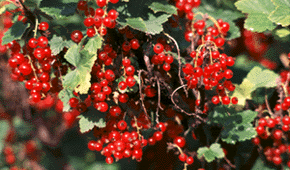
Red currants make the world's best jelly!
Like the Victory Gardens of our grandparents, edible landscaping can turn any growing space, large or small, into an incredible, edible resource!

Grape arbors thrived in ancient Egypt
If the idea of edible landscaping sounds a little far-fetched, you're not alone. Until recently, such applications were limited to apple orchards and quiet rows of raspberries. Yet, edible landscaping dates back to the gardens in ancient Egypt where flowers, grape arbors, vines and fruit trees were blended with places to sit and enjoy the scenery. By the Renaissance era though, things had changed. Gardens became more formal and segregated as gardeners planted herbs, orchards and vegetables in separate areas. Mixing and matching edibles with other plants became a thing of the past, at least for a while.
Then came the 1970s and edible landscaping experienced a comeback as people strived to do more with their land. Publications like Mother Earth News featured (and still do) back-to-the land success stories. Sales of fruit-bearing shrubs and trees, and the popularity of herbs reflected the renewed interest. The introduction of unusual vegetables to the home gardener by seedsmen like Renee Shepherd of Renee's Garden has also played a big role in how we arrange our gardens.
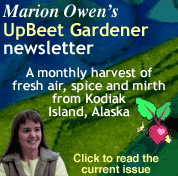 Today,
edible landscaping is alive and well in warm climates as well as cool
ones. Did you know that Manhattan's Central Park harbors several dozen
edible plants? And one out of every 5 plants--more than 500
species--in the Sonoran Desert provides good eating. Plus it's an easy way to provice healthy food for the table. We put edible landscaping to work to provide fresh salad greens and garnishes for our Galley Gourmet dinner cruises.
Today,
edible landscaping is alive and well in warm climates as well as cool
ones. Did you know that Manhattan's Central Park harbors several dozen
edible plants? And one out of every 5 plants--more than 500
species--in the Sonoran Desert provides good eating. Plus it's an easy way to provice healthy food for the table. We put edible landscaping to work to provide fresh salad greens and garnishes for our Galley Gourmet dinner cruises.
The combinations are endless. Uncommon fruit trees such as quince, persimmon, and pawpaw can enhance the most bland and stubborn landscape. That said, let's not forget the common but often overlooked edibles. Like rhubarb or gooseberries. European gardeners and gourmets have appreciated gooseberries for years, and in the U.S., gardeners are re-discovering gooseberries as an worthy home fruit. Thomas Powell, editor and publisher of The Avant Gardener (PO Box 489, New York, NY 10028), is a gooseberry cheerleader. "They may never supplant blueberries and raspberries as America's favorite garden bush fruits, but gooseberries are handsome and highly productive edible-ornamental."
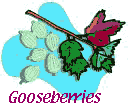
With small, maple-like leaves that blush nicely in the fall, gooseberries look well in borders and foundation plantings, and they can also be espaliered. As for flavor, the berries have been likened to kiwi, grapes and even tart apples, which makes them suitable for jams, wine, catsup and as a sauce baked with chicken or seafood.
More overlooked varieties include globe artichokes, red, black and white currants, which can be trained into attractive, compact hedges. Rhubarb too, with its bold red stalks and crinkly green leaves, is a show-stopper. And at the table, rhubarb recipes are also show-stoppers. Rainbow chard and the rich tones of Russian red kale add bursts of color to any grouping. And don't forget chives, fennel, thyme, lady's mantle, and other herbs. They deserve to be looked at in a whole new way.How to get started
If you've moved into a new home, then you have the luxury of starting from scratch. Just remember Landscape Rule Number One: Start with the "bones" by planting trees and shrubs first, then follow with smaller plants. But what if your yard is already established? Your task is equally as easy. Simply incorporate edible plants as you make changes.

Plant shrubs and trees first!
Begin by preparing your soil, enhancing it with compost,
mulch, kelp or manure
if necessary. (Organic materials improve all soils by adding structure
and nutrition,  and balancing the soil pH.) Then plant
a few vegetables and herbs among your annual flowers. At the same time,
let go of the habit of planting everything in nice neat, mono-cropped rows.
They'll do just fine inter-planted (mixed) with ornamentals and herbs.
and balancing the soil pH.) Then plant
a few vegetables and herbs among your annual flowers. At the same time,
let go of the habit of planting everything in nice neat, mono-cropped rows.
They'll do just fine inter-planted (mixed) with ornamentals and herbs.
In fact, inter-planting different plant families keeps pests at bay. Large groupings of broccoli and lettuce for example, attract concentrations of pests, while inter-planting tends to confuse them.
TIP: If your shrubs, trees, annuals or perennials wilt or become stressed from transplant shock, studies show that one of the best ways to give them a boost is to spray them with a kelp-fish foliar spray. I recommend PlanTea, the chemical-free, organic plant food I developed. Packed in small, easy-to-use tea bags, PlanTea is kid and pet-safe and is ideal for everything from tender seedlings to roses.
There are many good books on the subject of edible and organic landscaping, such as Ann Lovejoy's Organic Garden Design School (Rodale Organic Gardening Book) and Rosalind Creasy's, "The Complete Guide to Edible Landscaping." Both are available through Amazon.com.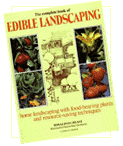
Out with the old, in with the new (edibles)
If you are faced with removing a tree that has died or outgrown its site, consider replacing it with a fruit-bearing one. Apples, currants, blueberries, Oregon grape (mahonia), raspberry, tayberry, red huckleberries, crabapples, plums, and cherries are just a few of the possibilities that provide color, texture, as well as food. And another tip: to put the forces of Nature in your favor, time your garden efforts, such as transplanting and pruning, to the phase of the moon. It works and it certainly can't hurt.
By the way, if you're looking for unique fruiting plants, trees, and berries, check out Raintree Nursery, in Morton, Washington (360-496-6400) and One Green World, in Molalla, Oregon (503-651-3005). (Warning: Looking through their catalogs will change your life).
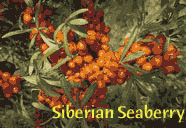
Sea Berries, an excellent source of vitamin C,
are available from One Green World.
Short on space? Consider planting in containers. Or how about reducing the size of your lawn? Shaving just a few inches of turf is hardly noticeable, yet it can be just the space you need to add a clump of herbs. Larger patches can be replaced with an edible groundcover such as strawberries or low-profile herbs. Strawberries tolerate marginal soils and light shade, plus they produce fruit through most of the summer. Dwarf dogwood (also called bunchberry), and herbs such as thyme and oregano maintain a low profile as handsome groundcovers.
Some tasty edible landscaping combos
Need ideas? Seed packets, books, magazines, garden centers and mail-order catalogs can help get the creative juices flowing. Let your imagination wander. Plant a border of lettuce, chives, green onions, pansies, and parsley along the edges of raised beds. Grow tall plants like dill, daylilies, fennel, valerian, peas, edible chrysanthemum, corn and beans in the back of beds or in the centers of containers. Consider shapes, too. Globe artichokes, garlic and sunflowers have showy tops; cherry tomatoes can show off in tubs or along a fence. Remember, you can get creative with garden art and whimsy, too. But that's another article.
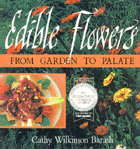
Bring on the edible flowers list
Edible flowers are a natural addition to gardens and kitchens. In her award-winning book, "Edible Flowers" (pictured above), Cathy Wilkinson Barash describes over 60 incredible edible flowers and shares 280 recipes to prove their "edibility." While at Amazon.com, be sure to look for Cathy's "Edible Flowers: Desserts and Drinks."
When it comes to edible landscaping, there are no hard-and-fast rules to follow, except to experiment with the amazing number of ways to combine food-producing and ornamental plants. The following plant combinations work well in full-sized gardens, raised beds, as well as containers and window boxes:
- Curly parsley and yellow pansies (Violas)
- Red leaf lettuce with yellow and orange calendulas
- Red chard and New Zealand spinach
- Dwarf curly kale with dusty miller, pink nemesia, and dianthus
- Curly parsley with trailing blue lobelia
- Oregano with red chard and trailing white lobelia
- Curly parsley and strawberries
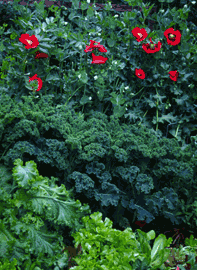
Snap peas (and blossoms),
mustard greens, poppies,
lettuce, kale and parsley. Photo by Marion Owen
And for plants with their incredible edible flowers:
- Sugar snap peas (white or pink-purple flowers, depending on the variety)
- Fava beans (white and burgundy)
- Pole beans
- Chives (lavender)
- Dill (yellow-green)
- Nasturtium (orange, red, yellow)
- Sage or salvia (colors vary, but mostly purple, blue and lavender).
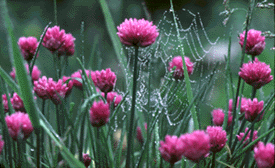
Chive blossoms: All parts are edible -- and decorative!
Red carrots and spotted nasturtiums
Some plants deserve a second look. Various kinds of cabbage, kale, leeks, onion, and sage for example, come in shades of gray and blue. Beets, chard, red cabbage, and purple mustard greens feature colorful shades. Carrots, endive, lemon balm, thyme and nasturtiums sport variegrated or mottled shades of white, yellow and light green foliage. Yarrow, dill and fennel have lovely green fernlike leaves that invite touching.
On the smelly side, the most fragrant edibles include chamomile, chives, fennel (brush your hand against it), mint, oregano, parsley, sage, and thyme. Basil, peppers and tomatoes are also quite sniffy.
Go on, hedge a little
Fences and hedges are naturals for edible landscaping. You can also make use of existing structures by training gooseberries, raspberries or currants along a fence. Espalier (es-PAL-ee-ay) a dwarf apple or gooseberry along a wall. Try using the plants' structure to support climbing plants like hardy kiwis, trailing nasturtiums, fava beans, or sugar snap peas.
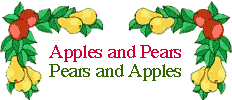
If you don't have a fence, plant a fruiting--and living--hedge. Shrub roses, such as the popular "rugosa," make a lovely and resistant barrier. Rugosas produce large red rose hips that contain 60 times the vitamin C of an orange. The hips can be used to make tea, jam, syrup or jelly.
Blueberries, highbush cranberries, gooseberries and raspberries also remain fairly compact as they grow. And they are easy to establish in the garden. Remember to keep in mind individual plant needs and growing habits. For example, blueberries and cranberries prefer an acidic soil (low pH); gooseberries a neutral one. And raspberries, while yummy, tend to invade adjoining spaces.

Edible landscaping not only adds an interesting twist to gardening, but it enhances your health and well-being at the same time. It's said that the healthiest food is found closest to the source. A cup of fresh-picked raspberries is ten times more flavorful and better for you than raspberries that traveled a thousand miles by truck to get to your kitchen.
So the next time you're thinking about improving your garden or yard, consider making it do double duty for you and your family by landscaping with incredible edible plants.
As always, I welcome your comments. Feel free to email me at mygarden@alaska.net. Meanwhile, keep your hands in the dirt and your dreams on a star. Cheers to you,
![]()
Thanks for visiting and please stop by again. I'll put the coffee on!
Meet Marion Owen /// Learn about PlanTea /// Online Catalog /// Articles, Tips, Recipes /// Get free UpBeet Gardener newsletter /// Read current issue /// Listen to radio show /// Read news and press releases /// More resources and links /// Learn why 'grow organic?' /// View guidelines for retailers /// Read love letters /// Book Marion as a speaker /// Site map /// How to link to us /// Contact us /// Go to home page
PlanTea: The organic plant food in tea bags. http://www.plantea.com
Copyright ©1996 to present: PlanTea, Inc. All Rights Reserved. PO Box 1980, Kodiak, AK 99615-1980 USA
Questions or comments? marion@plantea.com Phone: Toll Free: 1-800-253-6331 (US and Canada); 907-486-2500